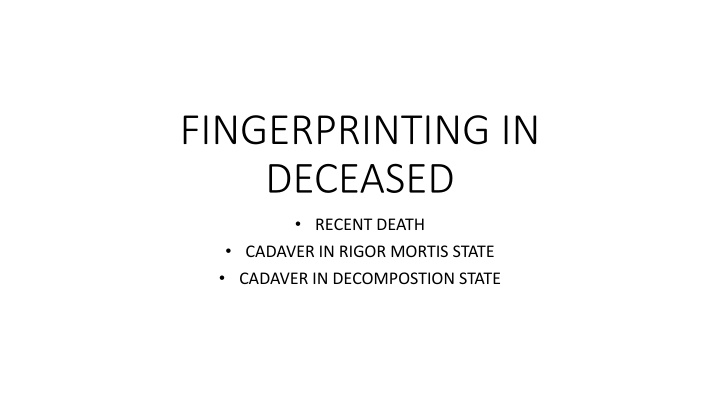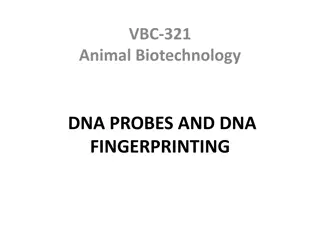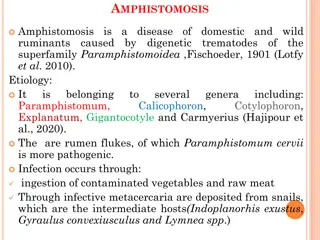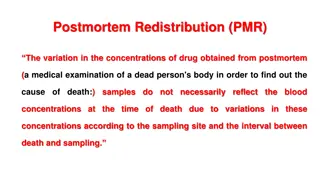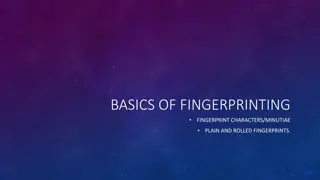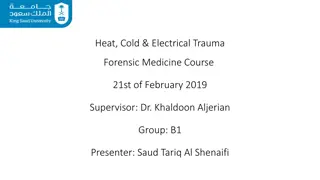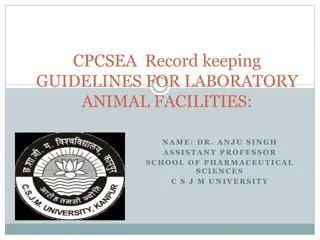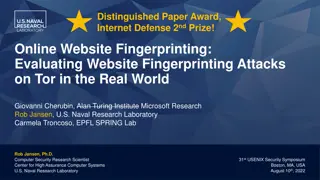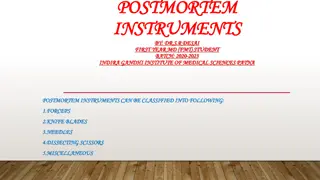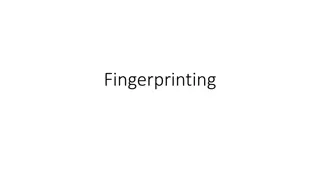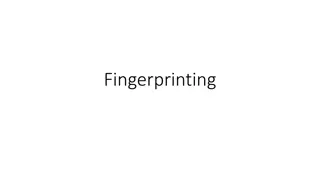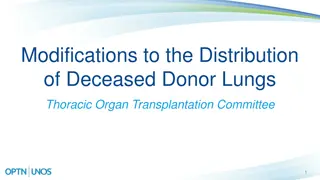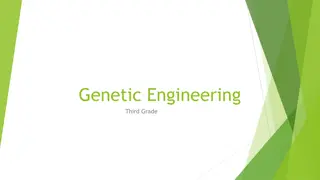Postmortem Fingerprinting Techniques in Deceased Individuals
Postmortem fingerprinting is essential in cases where identification is challenging due to factors like mass disasters or decomposition. This process involves preliminary preparations, methods of recording fingerprints, and specific techniques for cadavers in different states, such as recent death or rigor mortis. Proper handling and recording of fingerprints are crucial for accurate identification in forensic investigations.
Download Presentation

Please find below an Image/Link to download the presentation.
The content on the website is provided AS IS for your information and personal use only. It may not be sold, licensed, or shared on other websites without obtaining consent from the author.If you encounter any issues during the download, it is possible that the publisher has removed the file from their server.
You are allowed to download the files provided on this website for personal or commercial use, subject to the condition that they are used lawfully. All files are the property of their respective owners.
The content on the website is provided AS IS for your information and personal use only. It may not be sold, licensed, or shared on other websites without obtaining consent from the author.
E N D
Presentation Transcript
FINGERPRINTING IN DECEASED RECENT DEATH CADAVER IN RIGOR MORTIS STATE CADAVER IN DECOMPOSTION STATE
INTRODUCTION Postmortem fingerprinting is necessary when any body is beyond recognition (mass disaster, homicide, drowning or due to scavenger activity). Should be carried out only after completion of pathological examination as scrapings of nails might become contaminated with ink or powder.
PRELIMNARY PREPARATIONS Visual examination to determine whether the hands of cadaver are clean or soiled. If it is soiled, then the fingers are first cleaned by dipping hands in either soapy water or alcohol. To make fingers more flexible hands may be immersed in hot water for few minutes. (If required) Fingers should be dried (blotting with clean, lint freepaper towel or cotton, hair dryer) before proceeding for fingerprinting. Mid range photographs and close up photographs of each digit are taken.
METHODS OF RECORDING FINGERPRINTS Method of recording fingerprint is determine by the state/condition of cadaver. However, whatever be the method of recording, one should always take multiple impressions for each digit as due to wrinkles and depressions in skin, quality impression cannot be obtained in one single attempt.
RECENT DEATH If a corpse is found within 4 7 hr of death : fingers are flexible Fingerprint powder and lifting tape. Fingerprint Pad Fingerprint Ink
Fingerprint Pad Method Prints can be recorded by using fingerprint pad. Pad is rolled over the finger and then inked finger is rolled over the respective box of fingerprint card. Method is effective only when the fingers are flexible. Single digit fingerprint pad is more suitable for this purpose.
Fingerprint Ink Method Used when fingers are moderately fexible. A drop of ink is placed over spatula and spread out using horizontal roller. Ink is applied in fingertips with the help of spatula. Fingerprint card is placed in fingerprint spoon and it is rolled over inked finger. One finger is inked at a time and after recording its impression, another finger is inked.
Fingerprint spoons are curved metallic devices used for recording post mortem fingerprints
Fingerprint Powder And Tape Method Used if fingers are rigid. Black fingerprint powder is applied on the fingertip with fingerprint brush. Quantity of the powder should be sufficient to cover the entire fingertip. Excess powder is blown off. Fingerprint lifting tape is pressed firmly against the fingertip and then removed and pasted at appropriate box of the fingerprint card. As tape is elastic in nature, it confirms to the shape of the finger. Thus entire ridge pattern is recorded by this method.
CORPSE IN RIGOR MORTIS STATE Fingers need to be straightened before recording the imprints. Thus Rigor mortis needs to be removed. Hands are immersed in hot water, up to the wrist. If water is very hot then immerse it for one minute and if not vthen for two three minutes. Then take em out and dry with towel. If even after immersion method fingers are not straightened, then force is applied for breaking the rigor. Methods of breaking rigor mortis : Done by pressing on the finger just above the knuckle zone. Or by bending the wrist in direction of the forearm and press each finger close to the palm. If above methods fail then a finger straightener is used to unclasp the digits. In case where one is unable to break the rigor, doctor is asked to make the deep cuts on each fingers in the joints ( tendons).
CADAVER IN STATE OF DECOMPOSITION During early decomposition, skin of the fingers become shrunken and wrinkled at the bulb portion of the fingers. To remove these shrinkages and to restore fingers to its approximate original shape, glycerinated gelatin or air is used. Mixture of gelatin and glycerin in the ratio 1:7 or 1: 1 (v/v) is effective. Mixture is heated and hypodermically injected beneath the finger tissues. Air can be injected hypodermically to flatten the shrunken ridges. About 1-1.5 ml of air is injected to inflate the tissue.
Hypodermic needle is injected at the joint of the finger up into the tip of the finger. Injected until the finger "bulbs" are rounded out. In cases where injection of the fluid does not completely fill the finger bulb, Fluid is injected at other points of the finger such as the extreme tip or sides, until suitable results are achieved. Needle is quickly withdrawn and place is massaged to close the perforated spot.
NaOH Solution method : Digits are amputated. Done with a bone spine. Amputated digits are soaked in an aqueous solution of potassium hydroxide or sodium hydroxide. Each digit is immersed in a separate vessel. Strength of solution may vary form 1.5 %- 3%. Once the fingers reaches their original lengths , they are removed from the solution. Digits are then washed with distilled water and if the ridges become too soft due to oversoaking in NaOH, then soak the digits in 1-3% formaldehyde solution.
Xylene solution method Upper layer of ski is removed by using xylene. Layer is immersed in formaldehyde solution for few minutes. Layer is placed on operator s finger and inking is done to take the prints.
Formaldehyde solution If ridges are too soft then upper layer is immersed in stronger solution of formaldehyde i.e 9%. Formaldehyde retards the decomposition process and also hardens the skin layer. Operator wears gloves and places the upper layer of deceased s finger on his own fingers and prints are taken after inking.
In cases where first layer of skin is missing, or epidermis is broken down . the dermis or second layer of skin would be dealt with as though it were the outside skin. Skin is first loosened from the flesh by boiling in water. Then skin is peeled off and placed on a cardboard with inner surface turned outward. The ridge pattern is now reverse of the original. A better way is to take a cast of the underneath skin and then print from the mould.
Radiography method In cases where finger is badly decomposed, radiography is done. Photograph is taken by the means of X ray. An opaque material (barium sulfate or lead carbonate) is injected in the inner surface of the fingers, which are then X-rayed. The photographs display the bony structure of the fingers in addition to the ridge details. The latter are sufficiently clear as to identify the deceased.
Postmortem fingerprints are compared to Previous arrest records Military service records Federal employment records State driver s license records
